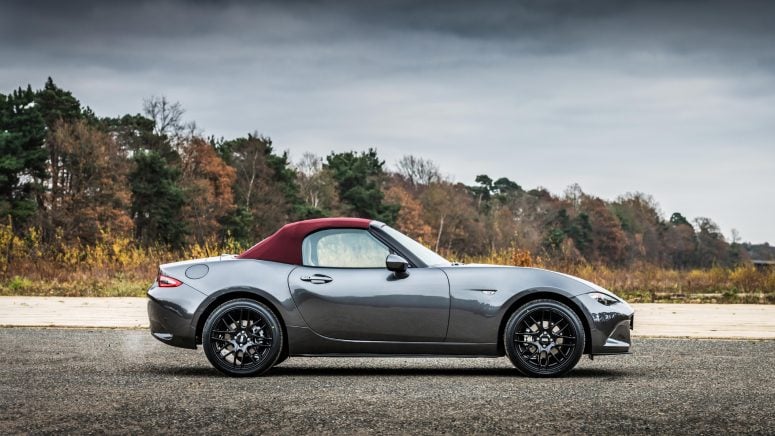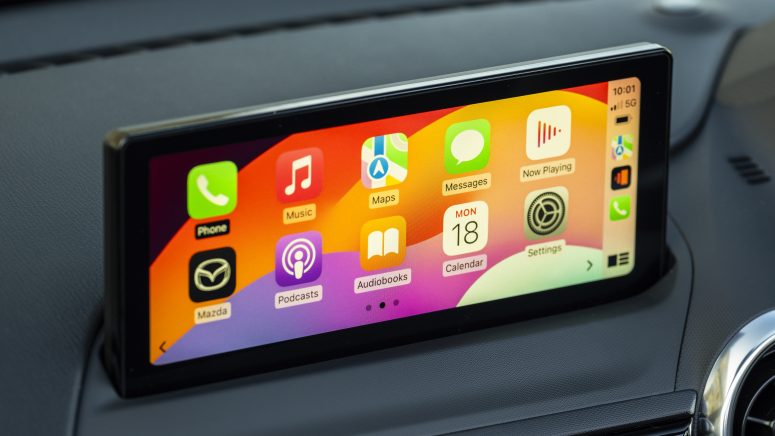Mazda MX-5
2015 - Present

Our verdict
The MX-5 is the last of a dying breed of small, affordable petrol-powered sports cars – and luckily for us, it's as good today as it's ever been. It's got practically no rivals of a similar size and price, and as a package it would be hard to beat in the first place.
Good bits
- Fantastic fun to drive
- Outside still looks fresh
- Engines suit it perfectly
Bad bits
- Interior starting to feel old
- Not designed for taller people
- Er... that's about it
Price
£25k - £37k
Made in
Japan
Engines
Petrol
Tell me about it
The MX-5 is a car that needs no introduction. But since we’ve got 1,500 words to fill, let’s have a go anyway.
It’s the car that reinvigorated the idea of a small, nimble, cheap to own sports car all the way back in 1989. Some 35 years later, and in its fourth generation, it’s still doing it – for now, at least.
There are two body styles available – a fabric-roofed roadster, or a folding hard top model called the RF – and a choice of two petrol engines.
Surprisingly, the model you’re looking at here – recently given a very mild update – has been on sale for nearly 10 years. Nobody seems to be complaining, mind.
Good question – not really. Closest in size and price is the Toyota GR86, which is strictly coupe-only. The larger, more expensive BMW Z4 and Porsche Boxster are also worth considering if you’ve got the cash.

Exterior
Compared to some of its rivals, the MX-5 is absolutely miniature. At less than four metres long it takes up less space on the road than a Ford Fiesta, and some models tip the scales at less than one tonne.
That weight is the result of some stringent dieting: Mazda’s engineers have shaved weight off in every possible area to ensure the MX-5 is as nimble as it can be.
It’s also a car that’s wearing its age very gracefully. 10 years after it was revealed, this generation of MX-5 still looks fresh today, thanks to its clean lines and neat exterior detailing.
To our eyes, the best looking version is the regular ‘Roadster’ with its manual-fold fabric roof. The ‘RF’, on the other hand, gets an electrically-deployable hard top – but thanks to its permanent rear pillars, feels more like a coupe with a removable sunroof than a convertible.
Not really, no. This is a slow-slung car with a very petite cabin. Things are a little easier when the roof is folded, but anyone particularly tall or with limited mobility may find getting in a struggle.
Yes, though its 130 litre boot is a bit of a squeeze for most items. It’ll hold two cabin-sized suitcases, but larger luggage will require some negotiating in through the relatively small opening.

Interior
While the outside is aging gracefully, the MX-5’s interior hasn’t fared quite so well over the years. Mazda has recently updated its infotainment system to the latest version, but everything else is a generation or two behind.
That means a steering wheel with slightly plasticky buttons, not much in the way of digital dials, and a bit of a plasticky ambiance in obvious places. But really, who cares? The MX-5 has never claimed to be a luxurious place in which to sit.
Keep that pared-back ethos in mind as you look around for storage areas. Door bins are non-existent, and there’s no room for a glovebox either. Mazda has popped a decent-sized lockable storage bin behind the occupants, but it’s a pain to reach any contents while you’re seated. You do at least get a pair of cupholders, though again, they’re not quite where you’d expect them to be.
It’s relatively easy to get comfortable behind the wheel – particularly in versions with Recaro sports seats. Do bear in mind that long-legged drivers and passengers may struggle to fit into the MX-5 in the first place, though, let alone find their ideal seating position.

Technology and equipment
For a relatively bare-bones car, Mazda has crammed a surprising amount of kit into the MX-5. Depending on trim level, you’ll find things like heated seats, climate control and a reversing camera.
Even the entry-level ‘Prime-Line’ trim gets plenty of standard equipment, including cruise control, an 8.8-inch infotainment screen with sat nav, and that all-important Apple CarPlay integration.
Soft-top MX-5 models get a manually-operated roof rather than electric one, but don’t worry, it’s a simple thing to put up and down. It does take a bit of physical effort to do so while seated, mind, so it’s best to test this out yourself before you buy.
The ‘RF’ get an electrically-deployable targa top instead, which operates by pressing and holding a switch next to the gear stick. It takes around 13 seconds to open, and can’t be operated when the car is travelling at more than 6mph.

Safety and security
The MX-5 hasn’t had a EuroNCAP crash test for nearly 10 years, so its previous score of four stars out of five has now expired. It’s fair to assume that its score won’t have improved on the newer, more stringent tests, as Mazda hasn’t made any meaningful changes to the passive safety systems of the car in that time.
That said, in recently-updated models you get all the usual mandated safety gear: lane keep assist, front smart city braking, and systems to monitor driver attentiveness. Better-equipped trim levels also get rear smart city brake support, blind spot monitoring and rear cross traffic alert.

Engines and performance
There’s two engines to choose from, and in classic Mazda style both are naturally-aspirated – that’s to say, they’ve got no turbochargers helping them along. The smaller 1.5-litre is good for 132bhp, while the beefier 2.0-litre pumps out a healthier 181bhp.
In reality, the MX-5 weighs so little that either engine is perfectly capable of whisking you along at a decent pace. If you want to be really true to the car’s ethos, opting for the 1.5 also means your car tips the scales at less than a tonne: quite an achievement in this day and age.
Despite a lack of clever hybrid tech, both engines are pretty efficient. The 1.5 manages 45.6mpg on the official combined cycle, and the 2.0 isn’t much worse at 41.5mpg.
Perhaps more importantly, they both sound fantastic, and offer more than enough performance to have fun with. It’s an old-school kind of thrill that you won’t find in many cars these days, and that’s more to the pity.

Ride and handling
As you might expect from a car of such tiny proportions and mass, the MX-5 is an absolute hoot to drive. When Mazda introduced this generation of car, they were aiming to replicate some of the sprit of the original model from 1989 – which, in itself, was trying to be a carbon copy of a 1960s British sports car.
The MX-5 doesn’t feel like it wants to hit every corner and roundabout at maximum attack. The suspension (in most trim levels) is on the softer side, but because there’s so little weight and you’re mere inches from the tarmac, it still feels lithe. It’s an involving, manual experience, and a real lesson in why less weight is a good thing.
If you do want an MX-5 with a bit more bite, all 2.0-litre models get beefier Brembo brakes, along with Bilstein suspension and a front strut brace to firm everything up. There’s even a limited slip differential – and if you have to ask what that is, you probably don’t need it.

Should I buy a Mazda MX-5?
Yes, you should. Go and buy one immediately while you still can. The MX-5 is the last of a dying breed of small, affordable petrol-powered sports cars – and luckily for us, it’s as good today as it’s ever been.
It’s got practically no rivals of a similar size and price, and as a package it would be hard to beat in the first place. Only a Toyota GR86 offers similar thrills, but is also only available in very limited numbers for regulatory reasons – a fate that may soon befall the MX-5 too.
The MX-5 isn’t for everyone, of course: particularly not those of us blessed with long limbs. But if you can fit one into your life, and fit inside it in the first place, you’re likely to be very happy together.
